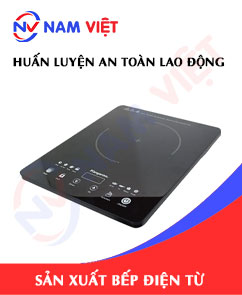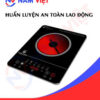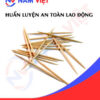Occupational Safety Training in Induction Stove Manufacturing
99,000 ₫
Note: The above price is calculated for one person, the price may fluctuate depending on the number of trainees participating in the course and depending on market movements. For more accurate pricing support, please refer to the quotation table or contact our consulting staff directly.
Occupational safety is an important issue in induction stove manufacturing factories and needs to be addressed promptly to ensure the health and safety of workers, and to enhance the reputation of businesses. The Occupational safety training course is one of the effective solutions to raise awareness about accident prevention for workers participating in induction stove manufacturing.
Table of Contents
Toggle1. Overview of Induction Stove
a. What is an induction stove?
An induction stove (Electromagnetic stove) is a type of stove that uses a magnetic field to transfer heat to the cooking pot. Instead of using flames like gas stoves or traditional electric stoves, the induction stove generates a magnetic field that stimulates molecules in the cookware to produce heat for cooking.
It includes an input power converter on the stove surface and a temperature sensor to control the heat. Induction stoves can be used with stainless steel or cast iron pots with thick bottoms but cannot be used with copper or aluminum cookware.
Induction stoves are generally considered a safer option compared to gas stoves because there is no risk of gas leakage, no harmful smoke, and they are easy to clean. They also save energy and are considered more environmentally friendly.

b. Machinery used for induction stove manufacturing
The machinery involved in the manufacturing and assembly of induction stoves includes:
- Steel stamping machine: Used to shape steel sheets according to the design of the induction stove.
- Metal cutting machine: Used to cut steel sheets into the desired sizes and shapes.
- Welding machine: Used to weld metal components together.
- Electronic circuit manufacturing machine: Used to produce and assemble electronic components in the induction stove.
- Packing machine: Used to package the parts of the induction stove before shipping to retail stores.
- Quality control machine: Used to check the features and quality of the induction stove before it is released to the market.
To manufacture and assemble induction stoves, producers need specialized machinery and equipment to ensure that the products meet quality and safety standards.

c. Induction stove manufacturers in Vietnam
Currently, there are many well-known induction stove brands on the market. Some popular brands include:
- Bosch: A German brand specializing in electronic household appliances and industrial machinery. Bosch induction stoves often feature elegant design, smart functions, and high performance.
- Electrolux: A Swedish brand specializing in household appliances. Electrolux induction stoves are highly rated for quality, features, and durability.
- Panasonic: A Japanese brand specializing in electronics, household appliances, and other technology products. Panasonic induction stoves are smart, user-friendly, and efficient.
- Midea: A Chinese brand specializing in household and electronic products. Midea induction stoves feature diverse designs, smart functions, and affordable prices.
- AEG: A Swedish brand producing household appliances. AEG induction stoves are elegantly designed, smart, and high-performing.
Other notable brands include Siemens, Samsung, Hitachi, and LG, which are also highly regarded in the induction stove market.
d. Specific roles in an induction stove manufacturing factory
Group 1
- CEO, Deputy CEO, and department heads in the induction stove manufacturing factory.
Group 2
- Safety officers: Manage workplace safety, design safety procedures, supervise, and enforce compliance with safe work processes.
Group 3
- Material procurement and control: Manufacturers purchase materials needed for induction stove manufacturing, including stainless steel, aluminum, copper, carbon steel, silicon, and electronic components.
- Manufacturing parts and components: Producing different parts and components such as the stove surface, induction coils, resistors, control buttons, display panels, casing, and other components.
- Product assembly: Assembling all parts and components, connecting them to create a complete product.
- Quality inspection: Checking the product’s quality before packaging and delivery to ensure safety and manufacturer standards are met.
- Packing and delivery: Packaging the inspected products and delivering them to retailers or end customers.
Group 4
- Office, service, sales, and marketing roles.
- Manufacturing management, quality management, human resource management, materials management, finance, and accounting management.
- Design and product research: Engineers and R&D staff work on designing, researching, and developing new or improved induction stove products.

2. Overview of occupational safety training for induction stove manufacturing
This article focuses on issues related to Group 3, as they are directly involved in the manufacturing process and face the highest occupational safety risks. Refer to other groups here.
a. What is Group 3 occupational safety training?
- Group 3 occupational safety training consists of sessions that provide awareness and knowledge to prevent workplace accidents for employees.
- The training helps workers recognize hazards, avoid risks, and reduce the likelihood of accidents while working.
REGISTER FOR OCCUPATIONAL SAFETY TRAINING SERVICES
b. Training duration
Initial safety training duration
- Total training time is at least 24 hours, including testing time.
- 8 hours of theoretical lessons on safety policies, laws, and labor hygiene
- 8 hours of theoretical lessons on basic safety and labor hygiene knowledge
- 4 hours of theoretical lessons on specialized training content
- 2 hours of practical lessons on specialized training content
- 2 hours of theoretical assessment at the end of the course
The safety training center will divide the schedule into multiple sessions depending on workers’ availability. Typically, there are 6 training sessions over 3 days, provided the company can allocate continuous study time.
Periodic safety training duration
- Before the occupational safety card expires, workers must undergo periodic safety training if they wish to renew, with training time at least 50% of the initial safety training duration.
Explanation: Total periodic safety training lasts at least 12 hours, including testing time. After completing the course and passing the assessment, workers will have their occupational safety cards renewed.
c. Training content
| No. | TRAINING CONTENT | TRAINING DURATION (HOURS) | |||
| Total | Breakdown | ||||
| Theory | Practical | Assessment | |||
| I | Safety policies and labor hygiene laws | 8 | 8 | 0 | 0 |
| 1 | Overview of the legal documents system on occupational safety and hygiene. | 6 | 6 | ||
| 2 | System of safety and labor hygiene standards and technical regulations. | 1 | 1 | ||
| 3 | Specific regulations from state management agencies on occupational safety and hygiene for newly built, expanded, or renovated facilities and equipment requiring strict safety and hygiene compliance. | 1 | 1 | ||
| II | Basic knowledge of occupational safety and hygiene | 8 | 8 | 0 | 0 |
| 1 | Basic knowledge of hazards and harmful factors in the workplace. | 4 | 4 | ||
| 2 | Methods to improve working conditions. | 1 | 1 | ||
| 3 | Safety culture in manufacturing and business. | 1 | 1 | ||
| 4 | Rights and obligations of employers and employees; safety policies for workers; roles of safety officers and networks. | 1 | 1 | ||
| 5 | Safety regulations, signs, instructions, use of safety equipment and personal protective gear; first aid and occupational disease prevention skills. | 1 | 1 | ||
| III | Specialized training content | 6 | 4 | 2 | 0 |
| Comprehensive knowledge of machines, devices, hazardous substances; risk analysis and management; safe work procedures for equipment and substances with strict safety requirements. | 6 | 4 | 2 | ||
| IV | End-of-course safety assessment | 2 | 2 | 0 | 0 |
| Total | 24 | 22 | 2 | ||
See more training content of all 6 groups
d. Occupational safety card
After completing the occupational safety training and passing the assessment, workers will be issued an occupational safety card (commonly referred to as the Group 3 safety certificate).
The Group 3 card shows the worker’s name, date of birth, specific job, and work environment. It also includes training duration, a red seal, and signature confirming course completion.
According to Clause 2 of Article 24 of Decree 44/2016/ND-CP, there are two cases:
- If the employer and employee have an employment contract, the employer must sign, stamp, and validate the safety card for the Group 3 trainee after completing the training and passing the assessment.
- If the worker is freelance or temporary and does not have an employment contract, the training unit must sign, stamp, and validate the safety card after the worker completes the training and passes the assessment.

3. Recognizing Hazards Affecting Workers During Induction Stove Manufacturing
During the manufacturing of induction stoves, workers may encounter the following hazards:
- Fire and explosion risks: Induction stoves use high and continuous electrical power; if not designed and manufactured according to proper procedures, incidents such as short circuits, fires, or explosions may occur.
- Chemical hazards: During manufacturing, workers may be exposed to chemicals, oils, cleaning agents, coatings, adhesives, and other solvents. If not used properly and without adequate protective measures, these substances can harm workers’ health.
- Occupational accidents: During manufacturing, workers may experience accidents such as impacts, cuts, or burns due to operating machinery or using equipment and tools incorrectly or unsafely.
- Electrical hazards: If electrical equipment in the factory is not regularly maintained, insulated, or waterproofed, it can cause electric shock risks for workers during manufacturing.
- Ultraviolet radiation hazards: During manufacturing, workers may be exposed to ultraviolet rays, which can harm skin and eyes. Without proper protective measures, this may lead to skin diseases, eye inflammation, and other health issues.
- Health deterioration from long-term operation: Manufacturing work requires exposure to noisy, vibrating, and fast-paced environments. Without proper protection, workers may suffer from neurological, musculoskeletal, cardiovascular problems, and stress.
4. Common Occupational Accidents During Induction Stove Manufacturing
Common occupational accidents for workers during induction stove manufacturing include:
- Burns: Certain manufacturing stages involve chemicals and materials that may cause burns on contact. Manufacturers should provide protective equipment such as gloves, helmets, masks, dustproof jackets, and safety glasses to minimize burn risks.
- Back pain and spinal issues: Manufacturing requires workers to operate heavy and bulky machinery frequently. Proper training in lifting, transporting, and operating equipment is essential to reduce the risk of back pain and spinal problems.
- Injuries from knives and cutting tools: Workers often use cutting tools such as knives during manufacturing. Incorrect usage or lack of protective gear may cause cuts or injuries.
- Electric shock risk: Workers handling electrical equipment such as cutting or welding machines may face electric shock if safety measures and proper techniques are not followed.
- Chemical poisoning: Workers may be exposed to harmful chemicals during manufacturing.

5. Safety Measures During Induction Stove Manufacturing
To ensure worker safety during induction stove manufacturing, the following safety measures should be implemented:
- Occupational safety training: Employees should be trained in safety and safe working procedures, and provided with safety information related to the machinery and materials used.
- Provide personal protective equipment: Employees should be equipped with safety glasses, masks, gloves, protective shoes, coats, etc.
- Regular inspections: Induction stove manufacturing machinery should be regularly checked to ensure safety and proper operation. Any malfunctioning equipment must be repaired or replaced.
- Use safe raw materials: Materials used in manufacturing must be safe and not harmful to employees’ health.
- Electrical safety: Machinery must be installed and maintained to ensure electrical safety and prevent short circuits.
- Use safe materials: Materials used in stove manufacturing must be safe and not harmful to end users.
- Maintain cleanliness and hygiene: Factories should be kept clean and hygienic to ensure safety for both workers and product users.
- Regularly conduct workplace environmental monitoring to collect and analyze harmful factors, adjust risks, and prevent occupational diseases.
6. Benefits of Occupational Safety Training for Induction Stove Manufacturing
An Toan Nam Viet provides your business with the following benefits after completing occupational safety training courses under Decree 44/2016/ND – CP regarding occupational safety and hygiene:
- Workers can recognize potential accident risks and take preventive measures to avoid them.
- Your business can establish risk prevention measures in manufacturing, operation, and maintenance processes.
- Reduce costs associated with safety incidents.
- Uninterrupted manufacturing increases labor productivity and product quality.
- Compliance with labor safety laws reduces legal risks.
- Enhances professionalism and credibility, improving your brand image.
Nam Viet’s training courses are designed to help individuals prevent external hazards, avoiding injuries or even fatalities.
REGISTER FOR OCCUPATIONAL SAFETY TRAINING SERVICE
7. Customer Feedback After Completing Occupational Safety Training for Induction Stove Manufacturing
An Toan Nam Viet has years of experience supporting businesses in Vietnam, especially in southern provinces. Our commitment has driven increasingly professional occupational safety training. Positive feedback and constructive suggestions from our partners fuel our growth. Below are testimonials from clients we have served.
See more customer interviews after using our service from An Toan Nam Viet
8. Occupational Safety Training Capacity of An Toan Nam Viet
An Toan Nam Viet is a reputable and high-quality occupational safety training center in Vietnam, providing continuous training at factories, manufacturing workshops, and construction sites nationwide (all 63 provinces).
REGISTER FOR OCCUPATIONAL SAFETY TRAINING SERVICE
Occupational safety training license
- An Toan Nam Viet has been inspected and certified by the Department of Safety under the Ministry of Labor – Invalids and Social Affairs, confirming compliance for occupational safety and hygiene training. This strengthens our training capacity.

Training materials and lectures
- Before being used in occupational safety training courses, materials are reviewed to ensure accuracy and effective application.
- Instructors follow standardized teaching methods from An Toan Nam Viet, developed by experts in occupational safety and hygiene training to maximize knowledge absorption.
Facilities
- Controlling classroom factors affects training efficiency and knowledge absorption.
- Our training facilities provide spacious classrooms meeting standards for area, lighting, and training equipment.
9. Nationwide Reputable Occupational Safety Training Center
At An Toan Nam Viet, we prioritize professional dedication to occupational safety training. Teaching workers self-protection knowledge helps them gain safety skills while contributing to national development.
We meticulously prepare all details, from teaching tools and equipment to curricula, documents, sound, and lighting.
Our instructors are experienced experts with research on hazard identification and prevention across industries.
Lectures are practical, vivid, and easy to understand, enabling workers to learn comfortably and effectively. Content aligns with Decree 44/2016/ND-CP.
Workers learn hazard prevention and self-protection techniques and apply them appropriately in real work situations.
Our training center provides professional and reputable occupational safety training with the following advantages:
- Competitive training costs without compromising quality.
- Flexible training schedules adapted to company manufacturing.
- Fast and lawful certification procedures.
- Experienced instructors with many years in the field.
- Classrooms optimized for teaching efficiency and knowledge absorption.
- Lectures tailored to workplace safety in businesses.
- An Toan Nam Viet provides dedicated, professional, and prompt support for clients.

10. Additional References for Occupational Safety Training in Induction Stove Manufacturing
- Occupational Safety Materials for Induction Stove Manufacturing
- Complete Occupational Safety Training Materials
- Occupational Safety Training Test Materials
- Occupational Safety Training Curriculum for Induction Stove Manufacturing
- Occupational Safety Multiple Choice Test for Induction Stove Manufacturing
1 review for Occupational Safety Training in Induction Stove Manufacturing
No comments yet















namchinh.haiphong341
Dịch vụ tốt!